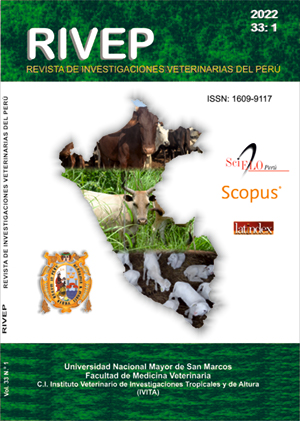Cysteamine and its applications in the in vitro production of embryos
DOI:
https://doi.org/10.15381/rivep.v33i1.20134Keywords:
ruminants, in vitro production, embryos, antioxidants, cysteamineAbstract
In vitro embryo production (IVP) is a biotechnology applied to different species of domestic and wild mammals, in addition to humans. IVP includes the in vitro maturation of oocytes (IVM), in vitro fertilization of matured oocytes (IVF) and the in vitro culture of fertilized oocytes (IVC). In the IVM and IVC processes there is an increase in levels of reactive oxygen species (ROS) that generate higher levels of oxidative stress, which together with a deficient antioxidant system in in vitro conditions can affect these processes. Faced with this situation, the maturation media are supplemented with antioxidant compounds such as cysteamine (CYS), which is an amino thiol (SCH2CH2NH) of low molecular weight (77.1 g/mol), has its own antioxidant activity, promotes the transport of cysteine to the interior of the cell and favours the synthesis of glutathione (GSH). Research on the use of CYS in IVP indicates that it stimulates GSH production, oocyte maturation and favours the segmentation and blastulation process. In addition, it has synergistic effects with other antioxidants or with growth factors, so the interest in this molecule and its effects on IVP has increased over the years. This review article presents the properties and effects of cysteamine in the in vitro production system of embryos in ruminants.
Downloads
Downloads
Published
Issue
Section
License
Copyright (c) 2022 Ruth Ortega Rojas, Gustavo Palma, Wilmer Vacacela Ajila, Rubén Carrera Durazno

This work is licensed under a Creative Commons Attribution 4.0 International License.
AUTHORS RETAIN THEIR RIGHTS:
a. Authors retain their trade mark rights and patent, and also on any process or procedure described in the article.
b. Authors retain their right to share, copy, distribute, perform and publicly communicate their article (eg, to place their article in an institutional repository or publish it in a book), with an acknowledgment of its initial publication in the Revista de Investigaciones Veterinarias del Perú (RIVEP).
c. Authors retain theirs right to make a subsequent publication of their work, to use the article or any part thereof (eg a compilation of his papers, lecture notes, thesis, or a book), always indicating the source of publication (the originator of the work, journal, volume, number and date).










